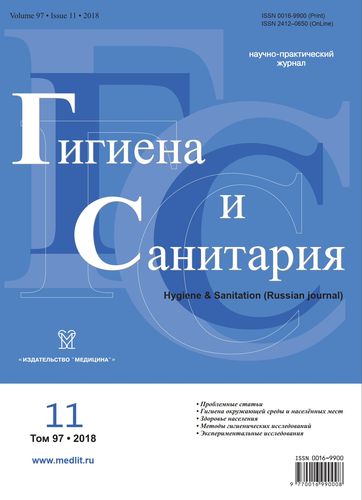On the possible particularity of Helicobacter Pylori Infection to Gallstone Disease
- 作者: German S.V.1, Modestova A.V.2, Zykova I.E.3, Bobrovnitsky I.P.1, Yakovlev M.Y.1
-
隶属关系:
- Centre for Strategic Planning, Russian Ministry of Health
- N.I. Pirogov Russian National Research Medical University
- Center of Medico-Biological and Ecological Problems of RAS
- 期: 卷 97, 编号 11 (2018)
- 页面: 1076-1079
- 栏目: POPULATION HEALTH
- ##submission.datePublished##: 20.10.2020
- URL: https://ruspoj.com/0016-9900/article/view/640490
- DOI: https://doi.org/10.47470/0016-9900-2018-97-11-1076-79
- ID: 640490
如何引用文章
全文:
详细
Introduction. Up to now, it has not been established whether Helicobacter pylori, the most common bacterial pathogen of human, is involved in cholelithiasis.
Material and Methods. Based on the analysis of prophylactic medical examination of working people in the Moscow region, the determination the pyloric Helicobacter infection and assessment of the virulence of bacteria there were studied the associations of H. pylori infection and gallstones. The infection was detected by the presence of serum specific antibodies of IgG class, the virulence of the strain H. pylori — by the presence of total antibodies to the protein associated with the cytotoxic gene CagA. There was used enzyme-linked immunosorbent assay. The study included 1,487 people, 931 men and 556 women aged 21-77 years.
Results. The H. pylori infection was detected in 1348 (90,6%), CagA protein in — 392 (56.2 %) cases. Gallstones were diagnosed in 72 patients, 21 men (2.3%) and 51 women (9.2%), 67 were seropositive (5% of all infected) and 5 — seronegative (3.6% uninfected). In cholelithiasis cases, the presence of CagA positive strain of H. pylori was investigated in 35 patients. A virulent strain of bacteria was detected in 26 cases (74%), much more often than in the rest examined persons.
Conclusion. There were no statistically significant differences in the incidence of cholelithiasis in infected H. pylori and non-infected individuals. A significantly higher prevalence of infection with pathogenic strains of H. pylori in patients with gallstones was found in comparison with the whole group of examined patients, that indicates to the favor of possible involvement of H. pylori infection in this pathology. Confirmation of the role of H. pylori infection as a cumulative risk factor for the gallstones cholecystitis, as well as for other extragastral pathologies, may have an epidemiological, prophylactic, clinical application, due to its widespread prevalence. Further research is needed.
作者简介
Serafima German
Centre for Strategic Planning, Russian Ministry of Health
编辑信件的主要联系方式.
Email: svgerman@yandex.ru
MD, Ph.D., DSci., leading researcher of the Centre for Strategic Planning, Russian Ministry of Health, Moscow, 119991, Russian Federation.
e-mail: svgerman@yandex.ru
俄罗斯联邦A. Modestova
N.I. Pirogov Russian National Research Medical University
Email: noemail@neicon.ru
俄罗斯联邦
I. Zykova
Center of Medico-Biological and Ecological Problems of RAS
Email: noemail@neicon.ru
俄罗斯联邦
I. Bobrovnitsky
Centre for Strategic Planning, Russian Ministry of Health
Email: noemail@neicon.ru
俄罗斯联邦
M. Yakovlev
Centre for Strategic Planning, Russian Ministry of Health
Email: noemail@neicon.ru
俄罗斯联邦
参考
- Sheptulin A.A., Lapina T.L., Kajbysheva V.O. New in the study of Helicobacter pylori infection. Provisions of the Conciliation Conference Maastricht V (2016). Rossijskij zhurnal gastroehnterologii, gepatologii, koloproktologii. 2017; 27 (1): 35-43.
- Reshetnikov O.V., Kurilovich S.A., Krotov S.A., Krotova V.A. Monitoring of Helicobacter pylori infection in Novosibirsk. Zhurnal mikrobiologii, ehpidemiologii, immunobiologii. 2008; 1: 99–100.
- German S.V., Zykova I.E., Ermakov N.V., Modestova A.V. The prevalence of infection H. pylori among the population of Moscow. Rossijskij zhurnal gastroehnterologii, gepatologii, koloproktologii. 2010; 2: 25–30.
- Isaeva G.SH., Abuzarova EH.R., Valeeva YU.V., Pozdeev O.K., Murav’eva E.V. Helicobacter pylori in patients with diseases of the hepatobiliary system. Zhurnal mikrobiologii, ehpidemiologii, immunobiologii. 2009; 2: 96-101.
- Abayli B., Colakoglu S., Serin M., Erdogan S., Isiksal Y.F., Tuncer I. et al. Helicobacter pylori in the etiology of cholesterol gallstones. J Clin Gastroenterol. 2005;39: 134-137.
- Neri V., Margiotta M., Francesco V., Ambrosi A., Valle N.D., Fersini A et al. DNA sequences and proteic antigens of Helicobacter pylori in cholecystic bile and tissue of patients with gallstones. Aliment Pharmacol Ther.2005;22: 715-720.
- Mishra R.R., Tewari M., Shukla H.S. Helicobacter species and pathogenesis of gallbladder cancer. Hepatobiliary Pancreat Dis Int. 2010; 9: 2.
- Lee J.-W., Lee D.H., Jung Il., Jeong S., Kwon K.S., Kim H.G. et al. Identification of Helicobacter pylori in gallstone, Bile and other hepatobiliary tissues of patients with cholecystitis. Gut Liver.2010;4 (1): 60-67. https://doi.org/10.5009/gnl.2010.4.1.60
- Kawaguchi M., Saito T., Ohno H., Midorikawa S., Sanji T et al. Bacteria closely resembling Helicobacter pylori detected immunohistologically and genetically in resected gallbladder mucosa. J Gastroenterol.1996;31: 294-298.
- Deeba J., Sanjay S., Abida M., Athar K. Helicobacter pylori in gall bladder disease. Biomed Res. 2010; 21 (4): 437-440.
- Dar M.Y., Ali S., Raina A.H., Raina M.A., Shah O.J., Mudassar S. Association of Helicobacter pylori with hepatobiliary stone disease, a prospective case control study. Indian J Gastroenterol. 2016; 35 (5): 343-346. https://doi.org/10.1007/s12664-016-0675-7
- Boonyanugomol W., Chomvarin C., Baik S.C., Song J.Y., Hahnvajanawong C. Chamsuwan A. Role of CagA-positive Helicobacter pylori on cell proliferation, apoptosis, and inflammation in biliary cells. Dig Dis Sci.2011; 56: 1682-1692.
- Мaurer K.J., Ihrig M.M., Rogers A.B., Ng V., Bouchard G., Leonard M.R., Carey M.C., Fox J.G. Identification of cholelithogenic enterohepatic Helicobacter species and their role in murine cholesterol gallstone formation. Gasnroenterology.2005; 128: 1023-1033.
- Mendez-Sanchez N., Pichardo R., Gonsales J et al. Lackof association between Helicobacter sp colonization and gallstone disease. J Clin Gastroenterol. 2001; 32: 138-141. https://doi.org/10.1097/00004836-200102000-00009
- Sherafat S.J., Tajeddin E., Majidi M.R.S., Vaziri F., Alebouyen M., Alizade A.H.M. et al. Lack of association between Helicobacter pylori infection and biliary tract diseases. Polish J Microbiol. 2012; 61 (4): 309-322.
- Zhou D., Wen-bin Guan, Jian-dong Wang, Zang Y., Gong W., Zhi-wei Quan. A comparative study of clinicopathological features between chronic cholecystitis patients with and without Helicobacter pylori infection in gallbladder mucosa. PLOS.2013; 8 (7): e70265
补充文件







